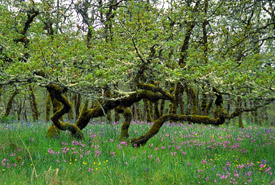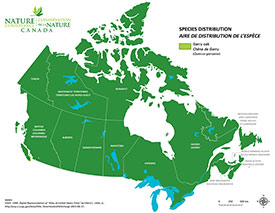
Garry oak, Cowichan Garry Oak Preserve, BC (Photo by Tim Ennis/NCC)
Garry oak
Where is this species found?
Many species of oak exist worldwide. Approximately 500 species of Quercus oaks have been identified by taxonomists, of which 95 occur in North America.
Garry oak is the only species of oak that is native to British Columbia. Its range is limited to a very narrow strip of sub-Mediterranean rain-shadow climate that extends down the eastern margin of Vancouver Island and throughout the southern Gulf Islands in BC, as far south as the San Joaquin valley in California.
What does it look like and where does it grow?
Also known as Oregon white oak, these trees can vary from extremely large and straight, single-stemmed trees that grow in lowland savannah to the more typical gnarled and twisted multi-stemmed trees that grow on thin soiled uplands.
Lowland oaks often grow in seasonally flooded areas, occasionally with wet-adapted species such as skunk-cabbage, while in dryer areas they can be found growing next to native brittle prickly pear cactus.
What is this species' ecological role?
Garry oak acorns provide an important source of food for Columbian black-tailed deer, band-tailed pigeon, Stellar's jay and other species. The larvae of the threatened propertius duskywing butterfly feed exclusively on Garry oak leaves.
The trunk and limbs of Garry oak are almost always covered in a thick, patchy layer of moss, which provides habitat for many species of insects. These provide food for a wide variety of birds, such as brown creeper and red-breasted nuthatch.
Garry oaks occasionally drop large limbs, exposing areas of rot in their trunks that are quickly adopted as shelters by woodpeckers and cavity-nesting songbirds.
What is this species' conservation status?
Less that one per cent of low-elevation Garry oak habitat and approximately five per cent of upland habitat remain in Canada today. This makes the Garry oak ecosystem one of the most endangered in Canada.
Every single plant community identified with Garry oak is listed in British Columbia as "critically imperiled."
In all, more than 100 species associated with Garry oak habitats are listed as either threatened, endangered, extirpated or extinct. Most of the endangered or threatened species are plants, with some butterflies as well.
Notable examples include:
- yellow prairie violet
- Howell's triteleia
- deltoid balsamroot
- Taylor's checkerspot
Many of the extirpated (locally extinct) species are cavity-nesting grassland birds such as:
- western bluebird
- Lewis' woodpecker
- acorn woodpecker
- streaked horned lark
What is NCC doing to protect habitat for this species?
The Nature Conservancy of Canada's (NCC's) Cowichan Garry Oak Preserve in Maple Bay (Vancouver Island) is one of the best remaining examples of this ecosystem left in the world.





